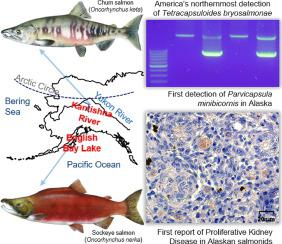International Journal for Parasitology ( IF 3.7 ) Pub Date : 2020-05-29 , DOI: 10.1016/j.ijpara.2020.03.010 Bartolomeo Gorgoglione 1 , Christyn Bailey 2 , Jayde A Ferguson 3

|
Proliferative kidney disease (PKD) of salmonids, a chronic immunopathology caused by the myxozoan parasite Tetracapsuloides bryosalmonae, is exacerbated by increased water temperatures. PKD causes economic concerns to trout farmers and contributes to the decline of wild salmonid populations in North America and Europe. The parasite occurs as far north as Norway and Iceland in Europe and was confirmed from California to southern British Columbia in the American continent. In mid-September 2011 adult chum salmon (Oncorhynchus keta) were sampled from Kantishna River, a tributary to Yukon River in Alaska. Clinical PKD was diagnosed based on the macroscopic appearance of mottled kidneys that were uniformly swollen and by the detection of tumultuous histozoic extrasporogonic and coelozoic sporogonic stages of T. bryosalmonae in renal tissue by histopathology. Archived samples provided the molecular confirmation and local strain identification, representing the first confirmed case of PKD in wild adult chum salmon, also co-infected with Parvicapsula minibicornis that represents another novel myxozoan detection in Alaska. Our investigation was extended to another case from August/September 1997, with mortality following furunculosis and ectoparasite co-infections, in sockeye salmon (Oncorhynchus nerka) pre-smolts net-pen reared in English Bay Lakes, Alaska. Immunohistochemistry on archived histological preparations confirmed T. bryosalmonae sporogonic and extrasporogonic stages, indicating a severe to resolving PKD, with concomitant Chloromyxum spp. infection. Those cases provide the first documentation that this parasite is present in Alaska and causes PKD in wild and cultured salmonids in the region. The known geographic range of T. bryosalmonae can be extended to ~267 km south of the Arctic Circle, representing the northernmost detection in America. Given the vast size of Alaska and small resident population, it is likely that T. bryosalmonae remained undetected, but more recently became evident due to the clinical manifestation of PKD, possibly linked to increasing water temperatures reported at the sample locations.
中文翻译:

阿拉斯加鲑鱼的增殖性肾脏疾病,有证据表明致病性粘液动物可能正在北方出现。
鲑鱼增殖性肾病 (PKD) 是一种由粘虫寄生虫Tetracapsuloides bryosalmona e引起的慢性免疫病理学,会因水温升高而加剧。PKD 给鳟鱼养殖者带来经济问题,并导致北美和欧洲野生鲑鱼种群的减少。这种寄生虫发生在欧洲最北的挪威和冰岛,从加利福尼亚到美洲大陆的不列颠哥伦比亚省南部都得到了证实。2011 年 9 月中旬成鱼 ( Oncorhynchus keta) 来自阿拉斯加育空河的支流康提什纳河 (Kantishna River)。临床 PKD 的诊断是基于均匀肿胀的斑驳肾脏的宏观外观以及通过组织病理学检测肾组织中苔藓沙门氏菌的组织生界外和体腔生孢子阶段的混乱。存档的样本提供了分子确认和局部菌株鉴定,代表了野生成年鲑鱼中首例 PKD 确诊病例,同时也感染了小角蚴,后者代表了阿拉斯加另一种新型粘虫检测。我们的调查扩展到 1997 年 8 月/9 月的另一个案例,红鲑鱼(Oncorhynchus nerka) 在阿拉斯加的英吉利湾湖区饲养的幼雏网笔。存档的组织学制剂的免疫组织化学证实T. bryosalmonae sporogonic 和 extrasporogonic 阶段,表明严重的解决 PKD,伴随着Chloromyxum spp。感染。这些案例首次提供了这种寄生虫存在于阿拉斯加并在该地区的野生和养殖鲑鱼中引起 PKD 的文件。T. bryosalmonae的已知地理范围可以扩展到北极圈以南约 267 公里,代表了美洲最北端的探测。鉴于阿拉斯加幅员辽阔,常住人口很少,苔藓鲑鱼很可能 仍未被发现,但由于 PKD 的临床表现,最近变得明显,这可能与样本位置报告的水温升高有关。











































 京公网安备 11010802027423号
京公网安备 11010802027423号